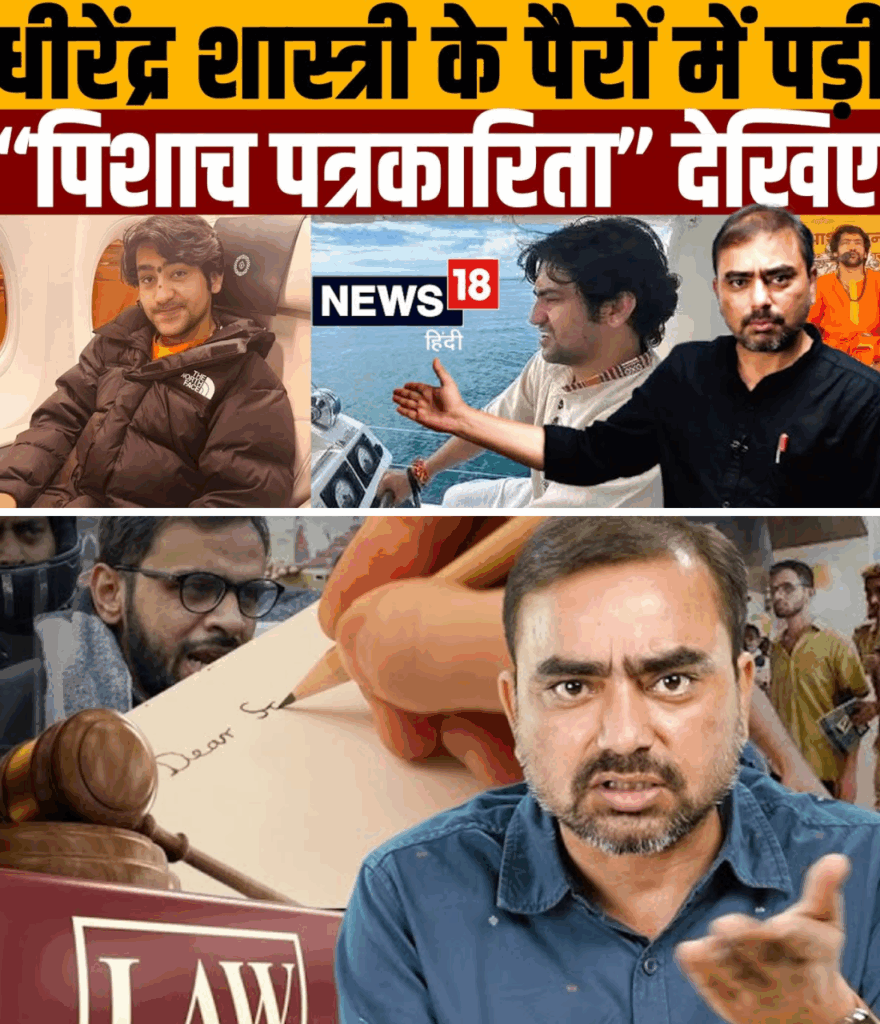India’s journalism landscape has witnessed several troubling trends over the years, from the emergence of “yellow journalism” (sensationalist and false reporting) to the chaos of television debates, where physical altercations between guests and anchors are no longer uncommon. Now, a new chapter has begun: “vampire journalism”—a term I use for the bizarre, superstitious, and exploitative stories that some TV channels have started promoting.
Recently, a prominent news website, NS18 (owned by Ambani’s group), published a sensational article on June 16th, written by journalist Parag Sharma. The piece speculated whether Dhirendra Shastri, popularly known as Bageshwar Dham Baba, receives supernatural guidance from a mystical entity called “Karn Pishachini” (a mythological female spirit who whispers answers in one’s ear).
This is not the first time Dhirendra Shastri has made headlines. Known for making controversial statements and boasting about his supposed supernatural powers, Shastri has attracted large crowds to his events, including prominent politicians like the President and Prime Minister. His “miraculous slips” (parchi) are a major draw at his gatherings, where he claims to reveal people’s secrets and solve their problems through divine intervention.

The article in question describes, in great detail, how Shastri allegedly hears mysterious voices from Karn Pishachini, enabling him to answer any question instantly. It even romanticizes the spirit as a beautiful apsara (celestial nymph) who appears before the practitioner. According to the article, this tantric practice is said to grant the power to know the past, present, and future, and is achieved through esoteric rituals.
However, critics argue that such stories are nothing more than elaborate hoaxes designed to exploit public gullibility and promote superstition. While magicians and mentalists openly admit that their acts are based on psychological tricks, self-proclaimed godmen like Shastri claim divine powers, misleading millions in the process.
The proliferation of such “vampire journalism” raises serious questions about the state of Indian media. Instead of fostering critical thinking and rationality, some channels are helping to brand and market superstition, often with the backing of powerful institutions.
Moreover, Dhirendra Shastri’s own credentials remain dubious—there is little information about his education, and he openly boasts about living off others’ donations without doing any real work. His derogatory remarks about women and his escape from responsibility during crises further undermine his credibility.
As the media continues to blur the line between news and entertainment, and between fact and fantasy, it is essential for viewers to remain vigilant. The rise of “vampire journalism” is a symptom of a deeper crisis in Indian society—a crisis of trust, reason, and faith.
News
Viral Video Sparks Controversy: Delhi Restaurant Accused of Denying Entry Over Indian Attire, Owner Responds
Viral Video Sparks Controversy: Delhi Restaurant Accused of Denying Entry Over Indian Attire, Owner Responds A video taken outside Tobata…
Raksha Bandhan with Khan Sir: Hundreds of Sisters Queue to Tie Rakhi, Muslim Students Join Celebration in Patna
Raksha Bandhan with Khan Sir: Hundreds of Sisters Queue to Tie Rakhi, Muslim Students Join Celebration in Patna The spirit…
Teacher in Banda Under Fire for Making Dance Reels During School Hours, Investigation Launched
Teacher in Banda Under Fire for Making Dance Reels During School Hours, Investigation Launched A teacher from Kasturba Gandhi Vidyalaya…
Communal Tensions Flare in Agra: Innocent Man Beaten After Rumors Spark Mob Attack at Hotel
Communal Tensions Flare in Agra: Innocent Man Beaten After Rumors Spark Mob Attack at Hotel A shocking incident in Agra’s…
Bigg Boss Fame Shehnaaz Gill Hospitalized Due to Health Issues; Fans Pray for Her Recovery
Bigg Boss Fame Shehnaaz Gill Hospitalized Due to Health Issues; Fans Pray for Her Recovery Shehnaaz Gill, known for her…
Tensions Erupt in Fatehpur Over Dispute Between Temple and Tomb Claims: Area Turns into Police Zone
Tensions Erupt in Fatehpur Over Dispute Between Temple and Tomb Claims: Area Turns into Police Zone A major controversy has…
End of content
No more pages to load






